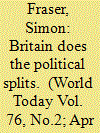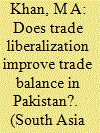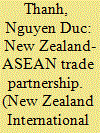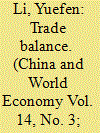|
|
|
Sort Order |
|
|
|
Items / Page
|
|
|
|
|
|
|
| Srl | Item |
| 1 |
ID:
171441


|
|
|
|
|
| Summary/Abstract |
We examine the asymmetric effects of oil supply shocks, shocks to global real economic activity, and oil-specific demand shocks on the oil, non-oil and overall trade balances of a large sample of oil exporters and oil importers. Our empirical strategy accounts for endogenous oil prices, heterogeneous parameters, and error cross section dependence within a panel framework. We find that the pattern of asymmetries in the oil price-trade balance relationship depends on the source of the shock. For both oil exporters and oil importers, oil supply expansions are more important than oil supply disruptions; we discuss the role that Saudi Arabia plays in limiting the global effects of oil supply disruptions. Although increases in global demand deteriorate trade balances for oil importers and improve them for oil exporters, decreases in global demand have a similar, rather than an opposite effect. Our results corroborate the existing evidence that oil price increases only generate large global imbalances if they result from demand-side shocks; and we present new evidence that oil price decreases only benefit oil importers if they result from supply-side shocks.
|
|
|
|
|
|
|
|
|
|
|
|
|
|
|
|
| 2 |
ID:
171589


|
|
|
| 3 |
ID:
081894


|
|
|
|
|
| Publication |
2008.
|
| Summary/Abstract |
China's sectoral trade composition, product quality mix, and the import content of processing exports have all changed substantially during the past decade. This has rendered trade elasticities estimated using aggregate data highly unstable, with more recent data pointing to significantly higher demand and price elasticities. Sectoral differences in these parameters are also very wide. All this suggests greater caution should be exercised when using historical data to simulate the response of China's economy to external shocks and exchange rate changes. Analyses based on models with estimated coefficients largely representative of China in the 1980s and 1990s are likely to turn out to be wrong, perhaps even dramatically.
|
|
|
|
|
|
|
|
|
|
|
|
|
|
|
|
| 4 |
ID:
157061


|
|
|
|
|
| Summary/Abstract |
This article examines the impact of trade liberalization, that is, reduction of tariff and non-tariff barriers on trade balance, in Pakistan over the period 1982–2013. The results reveal that reduction of average effective tariff rate improves trade balance in the short run, while lowering of non-tariff barriers deteriorates trade balance in the long run as well as in the short run. The analysis also suggests that depreciation of real effective exchange rate and foreign income causes an improvement in the trade balance, whereas domestic income deteriorates it. The negative association between the reduction in non-tariff barriers and trade balance worsens sustainability of current account of the balance of payments in Pakistan.
|
|
|
|
|
|
|
|
|
|
|
|
|
|
|
|
| 5 |
ID:
065485


|
|
|
|
|
| Publication |
Sep-Oct 2005.
|
|
|
|
|
|
|
|
|
|
|
|
|
|
|
|
| 6 |
ID:
088490


|
|
|
|
|
| Publication |
2009.
|
| Summary/Abstract |
This paper examines Sino-US trade relations, focusing on the ongoing process of global production sharing, involving splitting of the production process into discrete activities that are then allocated across countries, and the resulting trade complementarities between the two countries in world manufacturing trade. The results suggest that the Sino-US trade imbalance is basically a structural phenomenon resulting from the pivotal role played by China as the final assembly centre in East Asia-centered global production networks
|
|
|
|
|
|
|
|
|
|
|
|
|
|
|
|
| 7 |
ID:
137685


|
|
|
|
|
| Summary/Abstract |
This study investigates the possibility of improving the trade balance of Sri Lanka through currency depreciation. An error correction model (ECM) was used to examine the short-term and long-term effects of nominal and real effective exchange rate depreciation on the trade balance. While there is no long-run relationship between the real effective exchange rate and the trade balance, depreciation of the nominal effective exchange rate will lead to a deterioration of the trade balance in the long term. Further, the results indicate that there is a positive causality relationship from the real GDP to the trade balance. Conversely, growth in money supply will worsen the country’s trade balance in the long run. The empirical findings show that currency devaluation is not an effective policy tool to improve the country’s trade balance.
JEL Classification: F 140
|
|
|
|
|
|
|
|
|
|
|
|
|
|
|
|
| 8 |
ID:
173940


|
|
|
|
|
| Summary/Abstract |
This article investigates the impacts of China’s industrial plans on its exports and trade balance, and how they are magnified by the export controls to China by foreign countries. The empirical results show that China’s policy support to key-industries through Five-Year Plans has had a significantly positive impact on its exports and trade balance. Specifically, this key-industry support policy has brought about a 0.35% increase in China’s exports relative to imports since China’s WTO accession, while this impact drops to 0.3% for the USA. Taking the foreign export controls into account, the impact of the key-industry support policy on China’s trade surplus decreases significantly, which shows that the foreign export controls to China has magnified the impact of key-industry support policy on trade balance.
|
|
|
|
|
|
|
|
|
|
|
|
|
|
|
|
| 9 |
ID:
139720


|
|
|
|
|
| Summary/Abstract |
Nguyen Duc Thanh outlines the process by which New Zealand and Vietnam changed from neighbours to strategic partners.
|
|
|
|
|
|
|
|
|
|
|
|
|
|
|
|
| 10 |
ID:
170105


|
|
|
|
|
| Summary/Abstract |
Significant discrepancy exists between official Chinese and EU trade statistics on the magnitudes of the China-EU trade in goods as well as in services. While the discrepancy of China-U.S. trade surplus has been thoroughly studied by scholars and policymakers, the discrepancy of China-EU trade surplus is barely discussed in literatures. This may lead to seriously bias in understanding China-EU trade relationship, and even cause unnecessary trade friction. In this paper, we discuss the reasons behind the discrepancy of China-EU trade and quantify the extent to which the discrepancy is contributed by transportation costs, re-exports and their markups. We also employ the input-output tables of both EU and China, and measure the China-EU trade balance of goods and services in both domestic value-added (DVA) terms as well as in gross terms. The discrepancy of China-EU trade balance in goods (and services) still exists after adjustments, but is significantly reduced. With the adjustments on price and re-exports, in 2016, the discrepancy of China-EU trade in goods and services of Chinese release over EU release would shrink from an initial estimation of US$90.6 billion to an estimation of US$20.4 billion in gross terms, and further to US$15.8 billion in value-added terms.
|
|
|
|
|
|
|
|
|
|
|
|
|
|
|
|
| 11 |
ID:
127355


|
|
|
|
|
| Publication |
2014.
|
| Summary/Abstract |
The establishment of the World Trade Organization (WTO) has been widely accepted as representing the legalisation of world trading rules. However, it is important to reflect on the limits of this legalisation thesis in terms of the interface between international and domestic policy processes. By locating trading disputes in a political analysis of policy implementation, it is argued that it is difficult to establish conceptually how the WTO dispute settlement system could have authority separate from and above the conventional international politics of trade policy relations. Instead, the article argues that case outcomes should be expected to be largely the product of domestic political institutions and policy processes, and how these intersect with developments in the WTO dispute settlement system. Brief studies of the Australian government's dispute settlement strategy and two high-profile WTO disputes-the US upland cotton and European Union sugar cases-serve to suggest that the authority of international trade law is not as significant as assumed by the legalisation thesis. Rather, domestic politics and institutions have an important impact on the outcome of trade disputes.
|
|
|
|
|
|
|
|
|
|
|
|
|
|
|
|
| 12 |
ID:
070890


|
|
|
| 13 |
ID:
187845


|
|
|
|
|
| Summary/Abstract |
US multindoational enterprises sell considerable amounts of products to China's domestic consumers that are “made” in either China or other countries. However, these sales are not counted as US exports to China. To account for this, we propose a beyond-borders approach to measuring trade flows that explicitly considers firm ownership, termed “trade in factor income (TiFI),” that defines the US-owned factor income induced by China's final demand as US exports to China. Applying this approach to OECD data, we find that on average from 2005 to 2016 in TiFI terms, US exports to China were 20.34% and 8.21% greater, China's exports to the US were 1.64% and 16.04% less, and the US trade deficits with China were 17.4% and 32.0% less than the trade figures reported in value added and gross terms, respectively. The concept of TiFI transforms trade measures from a territory-based “made in” label to a factor income-based “created by” label.
|
|
|
|
|
|
|
|
|
|
|
|
|
|
|
|
|
|
|
|
|